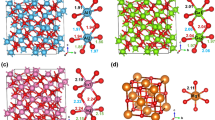Abstract
An approximate model for the defect structure of the niobium sulfide 2s Nb1+xS2 is developed on the basis of experimental data concerning its deviation from stoichiometry as a function of sulfur pressure. The model involves the presence of doubly-charged metal interstitials and metal vacancies as well as of free electrons and electron holes. The possible effects of hydrogen dissolution on the concentration of the intrinsic defects in this compound are also evaluated for various hydrogen species with an effective charge different from zero, but no final conclusion concerning the existence of an actual doping effect of this compound is reached. The rate constant for the sulfidation of niobium at 950°C is calculated on the basis of this defect structure as a function of the sulfur pressure and is compared with the experimental results concerning the sulfidation of niobium in H2-H2S mixtures. It is concluded that both metal vacancies and metal interstitials contribute significantly to the growth of the sulfide 2s Nb1+xS2
Similar content being viewed by others
References
J. P. Delmaire and H. Le Brusq,Compt. Rend. 275C, 889 (1972).
T. Tatsuki, M. Wakihara, and M. Taniguchi,J. Less Common Met. 68, 183 (1979).
D. Hodouin,Met. Trans. 6B, 223 (1975).
F. Jellinek, G. Brauer, and H. Muller,Nature 185, 376 (1960).
F. Jellinek,Arkiv. Kemi 20, 447 (1963).
F. Kadijk and F. Jellinek,J. Less Common Met. 19, 421 (1969).
C. N. R. Rao and K. P. R. Pisharody, inProgress in Solid State Chemistry, Vol. 10, J. O. McCaldin and G. Somorjai, eds. (Pergamon Press, New York, 1975), p. 207.
P. Kofstad,High Temperature Corrosion (Elsevier Applied Sci., London, 1988).
E. Garstein, T. O. Mason, and J. B. Cohen,Advances in Ceramics, The American Ceramic Soc., Vol. 23 (Westerville, Ohio, 1987), p. 699.
S. Mrowec and J. Janowski, inSelected Topics in High Temperature Chemistry, Vol. 9, O. Johannesen and A. G. Andersen, eds. (Elsevier, Amsterdam, 1989), p. 55.
A. Atkinson, inSelected Topics in High Temperature Chemistry, Vol. 9, O. Johannesen and A. G. Andersen, eds. (Elsevier, Amsterdam, 1989), p. 29.
C. Wagner, inProgress in Solid State Chemistry, Vol. 10, J. O. McCaldin and G. Somorjai, eds. (Pergamon Press, New York, 1975), p. 1.
R. Dieckmann,Zeit. Phys. Chem. N.F. 107, 189 (1977).
G. E. Murch,Atomic Diffusion Theory in Highly Defective Solids (Trans. Tech. SA, Aedermannsdorf, 1980).
F. A. Kroger and H. J. Vink, inSolid State Physics, Vol. 3, F. Seitz and D. Turnbull, eds. (Academic Press, New York, 1956).
B. S. Lee and R. A. Rapp,J. Electrochem. Soc. 131, 2998 (1984).
W. H. Cheung and D. J. Young,Oxid. Met. 36, 15 (1991).
W. Znamirowski, F. Gesmundo, S. Mrowec, M. Danielewski, K. Godlewski, and F. Viani,Oxid. Met. 35, 175 (1991).
F. Gesmundo, F. Viani, and S. Mrowec,Solid State Ionics,50, 139 (1992).
T. Norby and P. Kofstad,Solid State Ionics 20, 169 (1988).
T. Norby, inSelected Topics in High Temperature Chemistry, Vol. 9, O. Johannesen and A. G. Andersen, eds. (Elsevier, Amsterdam, 1989), p. 101.
F. A. Kroger,The Chemistry of Imperfect Crystals (North-Holland, Amsterdam, 1964).
S. Kovalchenko,Izvest. Acad. Nauk. SSR Met. 5, 221 (1974).
M. Danielewski, Proc. Eurocorr. '87, Dechema, Frankfurt, 1987, p. 223.
K. N. Strafford and J. R. Bird,J. Less Common Met. 68, 223 (1979).
K. N. Strafford and D. Jenkinson, inCorrosion Resistant Materials for Coal Conversion Systems, D. B. Meadowcroft and M. I. Manning, eds. (Applied Sci. Pub., London, 1983), p. 551.
K. N. Strafford, A. F. Hampton, and D. Jenkinson, inHigh Temperature Alloys-Their Exploitable Potential, J. B. Marriott, M. Merz, J. Nihoul, and J. Ward, eds. (Elsevier, London, 1988), p. 165.
F. Gesmundo, F. Viani, and K. Godlewski, Proc. 7th Asian-Pacific Corrosion Control Conference, Vol. I, International Academic Publishers, Beijing, 1991, p. 90.
F. Gesmundo, F. Viani, and D. J. Young,Oxid. Met. 38, 309 (1992).
F. Gesmundo and F. Viani,J. Phys. Chem. Solids 42, 777 (1981).
S. Mrowec and K. Przybylski,High Temp. Mater. Proc. 6, 1 (1984).
H. Rau,J. Phys. Chem. Solids 41, 765 (1980).
Author information
Authors and Affiliations
Rights and permissions
About this article
Cite this article
Gesmundo, F., Viani, F. & Niu, Y. The defect structure of 2s Nb1+xS2 and the high-temperature sulfidation of niobium. Oxid Met 38, 465–482 (1992). https://doi.org/10.1007/BF00665664
Received:
Revised:
Issue Date:
DOI: https://doi.org/10.1007/BF00665664




